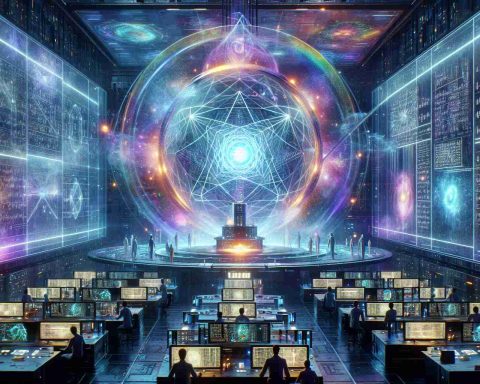- Moth Quantum leverages quantum computing to revolutionize music, visual arts, and gaming.
- Key tools include the Quantum Audio Platform and Sphinx App, enabling new creative possibilities.
- While offering innovation, quantum technology presents challenges like complexity and cost.
- Applications range from music composition to immersive gaming, enhancing audience interaction.
- Future trends show growing artistic movements and Moth Quantum’s commitment to sustainability.
- This technology fosters a progressive art culture, blending creativity with technological advancement.
Dive into a world where artistry and technology collide, as Moth Quantum, a cutting-edge startup from London and Basel, transforms the creative landscape by using the power of quantum computing. Imagine a realm where music, visual arts, and gaming transcend traditional boundaries, exploring new horizons of creativity.
Unveiling Moth Quantum’s Innovations
At the heart of Moth Quantum’s offerings are pioneering tools like the Quantum Audio Platform and the Sphinx App. These platforms push the limits of soundscapes and musical compositions, utilizing quantum reservoir computing to craft experiences beyond the reach of classical techniques. With these tools, artists can venture into uncharted territories of creativity, crafting audio pieces that challenge existing norms.
The Pros and Cons of Quantum Creativity
This quantum leap in the arts brings both opportunities and challenges. On one hand, artists gain unprecedented access to innovation, experimentation, and collaboration. Yet, the technical complexity and cost barriers might hinder widespread adoption, especially for independent creators. However, for those who dare to embrace it, a world of unimaginable artistic expression awaits.
Real-World Applications
From music composition to immersive game design and dynamic visual art, Moth Quantum champions a new era where audience interaction and real-time data redefine artistic experiences. This approach not only enriches the art itself but fosters community engagement, making technology an accessible part of the creative process.
Challenges and Future Trends
While groundbreaking, quantum technology in the arts faces hurdles such as complexity and market acceptance. Yet, as the technology matures, more artists are expected to explore these innovative tools, leading to fresh art movements and previously unimagined forms of expression. Additionally, Moth Quantum is committed to sustainability and security, ensuring a responsible legacy for future art forms.
Join the revolution as quantum computing weaves its magic into the fabric of creativity, offering a glimpse into art’s exciting future. By merging imagination with technical brilliance, Moth Quantum is poised to not only reshape the art world but perhaps even spark a cultural renaissance.
How Quantum Computing is Revolutionizing the Arts: What You Need to Know
Discovering Moth Quantum’s Groundbreaking Tools
At the forefront of Moth Quantum’s innovation are their revolutionary platforms: the Quantum Audio Platform and the Sphinx App. These pioneering tools harness quantum reservoir computing to redefine musical and artistic experiences. By breaking away from traditional techniques, they allow artists to create soundscapes that were previously unimaginable, offering a new dimension to musical compositions and creative processes.
The Advantages and Challenges of Quantum Creativity
# Pros:
1. Unparalleled Creativity: Artists can access groundbreaking forms of artistic expression, pushing the boundaries of what is creatively possible.
2. Innovative Experimentation: Quantum computing opens new avenues for innovation in art, enabling more interactive and dynamic experiences.
3. Collaborative Potential: Technology facilitates new opportunities for collaboration among artists worldwide, fostering a global artistic community.
# Cons:
1. Technical Complexity: The complexity inherent in quantum computing may pose a barrier to entry for many artists, particularly independent creators.
2. Cost Factor: The high costs associated with implementing quantum technology can limit its accessibility and widespread adoption.
Exploring Real-World Applications
Moth Quantum is transforming diverse fields such as music composition, immersive gaming, and dynamic visual art. By incorporating quantum data, these tools not only enhance the art itself but also increase audience engagement, making artistic experiences more interactive and collaborative. This bridges the gap between technology and creativity, democratizing the artistic process for a broader audience.
Overcoming Challenges and Embracing Future Trends
As with any groundbreaking technology, quantum computing in the arts is not without its challenges. Artists must navigate its complexity and market acceptance. However, as the technology matures, a growing number of artists are expected to leverage these innovative tools, leading to novel art movements and previously unimaginable forms of artistic expression.
In addition to driving innovation, Moth Quantum is committed to sustainability and security, ensuring that their advances in technology also respect environmental and ethical considerations, setting a responsible precedent for future art forms.
Key Questions and Answers
1. How can artists start integrating quantum computing in their work?
Artists interested in exploring quantum computing can begin by experimenting with tools like the Quantum Audio Platform and Sphinx App, provided by Moth Quantum. These platforms offer an accessible entry point for those looking to combine technology with creativity, enabling unique soundscapes and artistic experiences.
2. What are the major challenges for artists adopting quantum technology?
The primary challenges include the complexity of the quantum computing process and the associated costs. Artists must also consider the learning curve required to harness these new technologies effectively, as well as the initial investment needed for incorporation into their work.
3. What future trends can we expect from quantum art forms?
Future trends in quantum art may include increased interactivity, enhanced audience participation, and greater collaboration across disciplines and geographies. As more artists adapt to quantum technology, we may witness the rise of innovative art forms that transcend traditional boundaries, offering new experiences for both creators and consumers.
For more on the intersection of technology and creativity, visit Moth Quantum.
The source of the article is from the blog motopaddock.nl














